Koh Rong Samloem: Where to Stay, Swim, and Slow Down
I spent my 30th birthday on a quiet island in Cambodia, swimming in warm water and watching the sky turn orange over the ocean. After fifteen months of moving constantly, it was exactly what I needed: five days with no real agenda, no must-sees, no rush. Just stillness.
Koh Rong Samloem is where we chose to end our nomadic chapter before moving to Canada. It’s not the kind of island that demands much from you, which is exactly its appeal. The beaches are soft, the days pass slowly, and the loudest thing you’ll hear is the occasional longtail boat pulling into shore.
This is a guide to the island I picked when I wanted to rest. If you’re looking for the same – or just want to know what Koh Rong Samloem is actually like before you commit to a ferry – here’s everything you need to know.
Where Is Koh Rong Samloem?
Koh Rong Samloem is a small island off the southern coast of Cambodia, in the Gulf of Thailand. It sits just 25 kilometers from the mainland town of Sihanoukville, and only about 5 kilometers south of the more developed island of Koh Rong. Despite being close neighbors, the two islands offer vastly different experiences.
While Koh Rong is the better-known of the two – with bars, scooters, and a growing network of roads – Koh Rong Samloem is still mostly off-grid (at least as of 2025). There are no paved roads, only sandy trails and boats connecting its beach settlements.
Travelers typically arrive by speed ferry from Sihanoukville, landing at one of a few main piers depending on where they’re staying.
Though the island isn’t large, each area feels distinct, with its own character – from backpacker-friendly M’Pai Bay to the peaceful stretches of Lazy Beach and Sunset Beach.
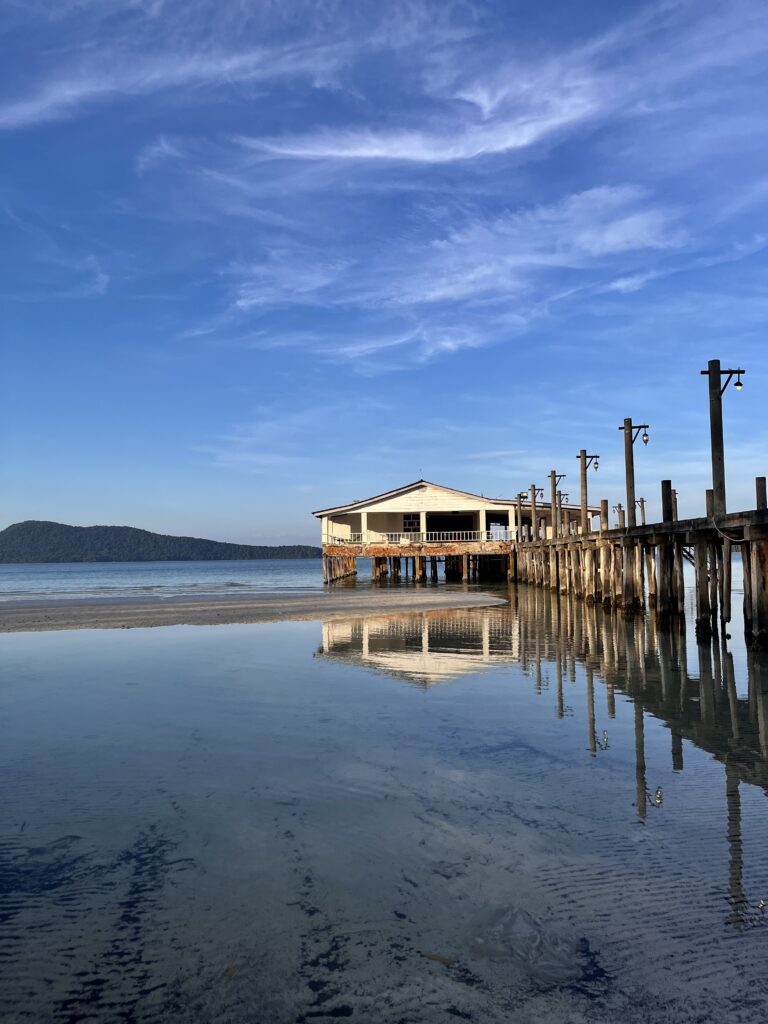
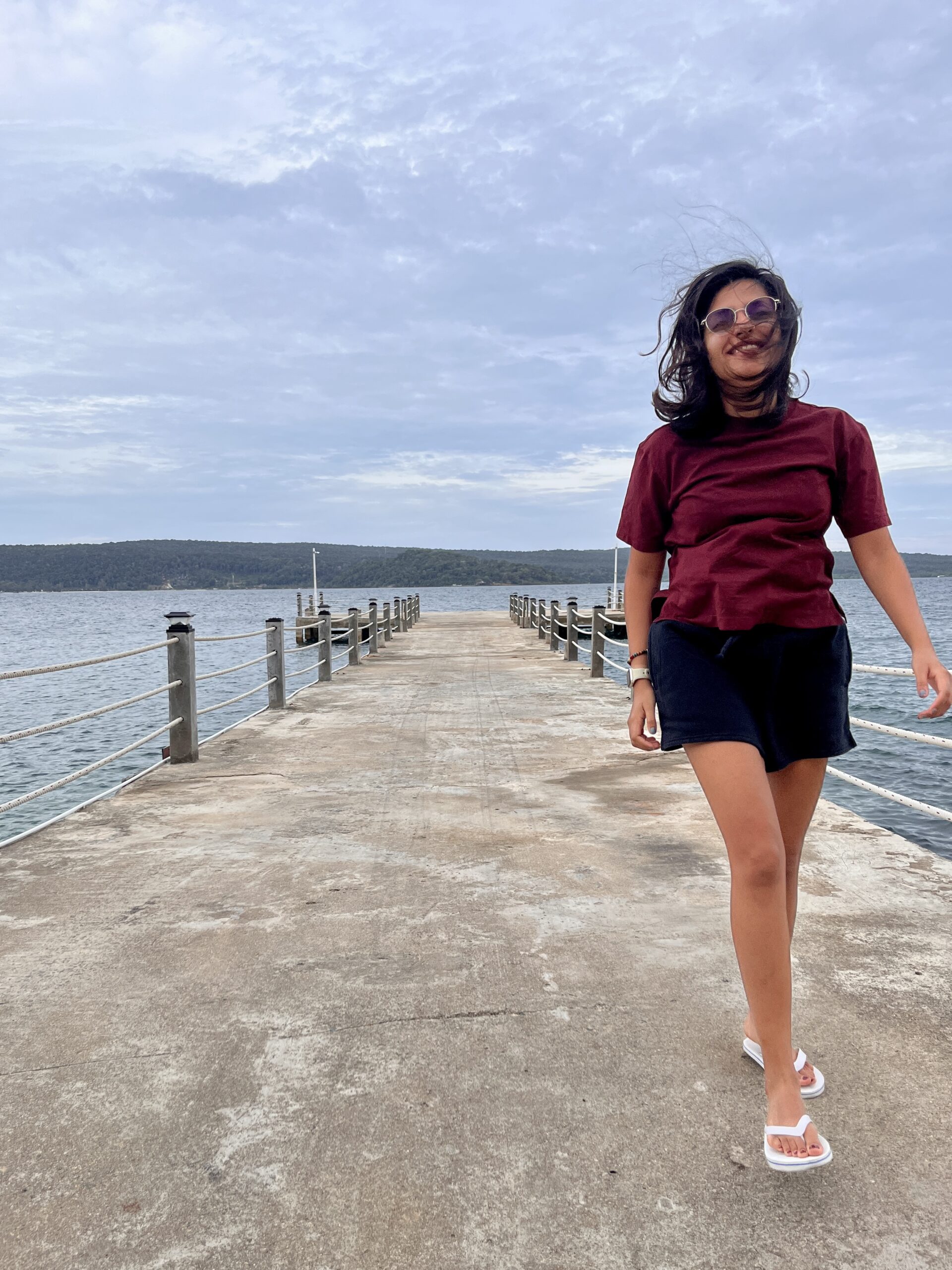
How to Get to Koh Rong Samloem?
Getting to Koh Rong Samloem is a two-part journey: first to Sihanoukville on Cambodia’s southern coast, and then onward by ferry to the island. While we personally made the trip from Phnom Penh (and share more in our Cambodia itinerary), the steps are similar regardless of where you’re coming from.
Step 1: Reach Sihanoukville
You can get to Sihanoukville by road or air:
- By Bus or Minivan: The most common route from Phnom Penh takes about 4 to 6 hours depending on traffic. Minivans are faster and more direct; buses are cheaper but slower.
- By Private Taxi: A good option if you’re in a group. Expect to pay around $70–$80 for the drive.
- By Flight: There are occasional domestic flights from Phnom Penh or Siem Reap, though schedules can be unpredictable and should be double-checked ahead of time.
We traveled from Phnom Penh in the morning without an overnight stop in Sihanoukville. At the bus terminal, we were handed off to the person coordinating ferry tickets – many services bundle both transport legs together, making it surprisingly easy to arrange.
Sihanoukville itself was a shock. Glossy high-rises sat beside empty lots and tarped construction sites. The whole town felt like a casino development mid-glitch – half-built, strangely quiet, and marinated in plastic waste. It was hard to reconcile this place with the seaside destination I’d read about.
Chinese investment has transformed Sihanoukville into a speculative boomtown, with large-scale casino and real estate projects displacing locals and reshaping the skyline. We were just passing through, but the contrast between this chaotic mainland hub and the quiet, unhurried island we were headed to felt like stepping between worlds.
Once in Sihanoukville, you’ll need to get to the Autonomous Port (PAS) – most ferry operators to Koh Rong Samloem depart from here. Each company serves different beach piers on the island, so confirm where your accommodation is located and make sure your ferry ticket matches. Not all services stop at every pier unless asked.
💡 Bring enough cash for the island – there are no ATMs on Koh Rong Samloem, and you may be charged extra to pay by card at the ferry counters.
Step 2: Ferry to Koh Rong Samloem
Ferries typically leave in the early afternoon (around 2:00–2:30 PM) and take 45–60 minutes depending on sea conditions and the number of stops.
Here’s a breakdown of the main piers and which area they serve:
- Saracen Bay Pier – For most mid-range resorts and guesthouses
- M’Pai Bay Pier – For the budget backpacker village in the north
- Paradise Pier – For Pearl Beach Resort & Spa (where we stayed)
- Sunset Beach & Lazy Beach – Require a jungle hike or boat transfer from Saracen Bay
🛎️ Important: Let the ferry staff know your accommodation before boarding. This ensures you’re dropped off at the right pier – some boats don’t stop at all locations unless requested.
A Note on the Return Trip
Returning to the mainland in one day is doable but less flexible. The earliest ferries usually leave around 11:00 AM, and delays are common during rough weather. If you’re catching a bus or flight that same day, allow a generous buffer to avoid cutting it close.
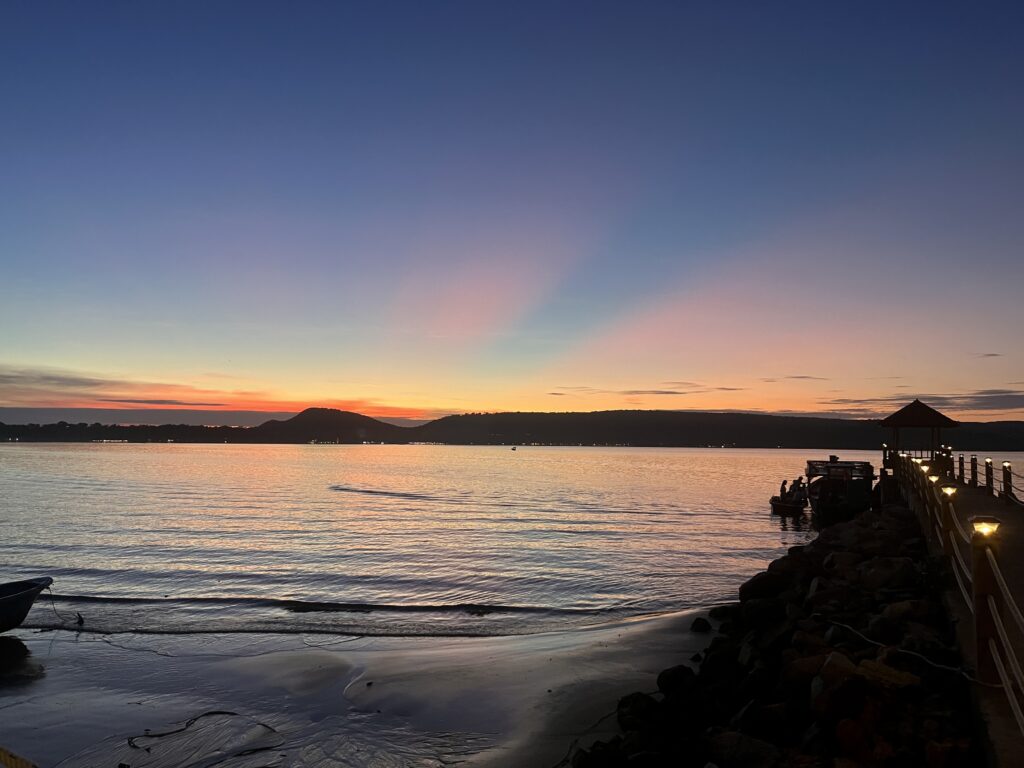
Koh Rong vs Koh Rong Samloem: Why We Picked This Island
Both islands are known for their beaches, but they offer very different experiences. Koh Rong is larger and more developed. There’s more infrastructure, more nightlife, and more variety. For some travelers, that’s exactly what they’re looking for.
But we weren’t those travelers – not at that point, anyway.
After more than a year of constantly moving, I didn’t want an island to explore. I wanted an island to stop on. Somewhere beautiful and easy, where we wouldn’t feel the pressure to “make the most of it.” We were also celebrating my 30th birthday, and this was one of the few moments in our trip when I felt okay splurging a little.
Koh Rong Samloem ended up being the right choice. It’s smaller, quieter, and a little harder to get around, but also more peaceful. There are fewer restaurants, no party scene, and not a lot to “do.” But that was exactly the point.
How to Get Between Koh Rong and Koh Rong Samloem
The two islands are just 5 kilometers apart, and getting between them is quick and easy.
You have two options: local boat taxis or inter-island ferry companies. Most travelers take the boat taxis, which you can catch from the Koh Rong Community Pier. These small, no-frills boats usually cost around $5 USD per person and take 20–30 minutes, depending on sea conditions.
There’s no fixed schedule – timing and price can vary – so it’s best to check with your accommodation the day before. Most resorts and guesthouses are happy to help arrange the transfer.
A few ferry operators also offer limited services between the islands. These run less frequently, so the boat taxi is usually your more flexible option.
Before you leave Sihanoukville, top up your cash – most inter-island transfers are cash only, and card payments often come with an added fee.
If you have time to explore both islands, this is an easy side trip that adds some variety to your stay.
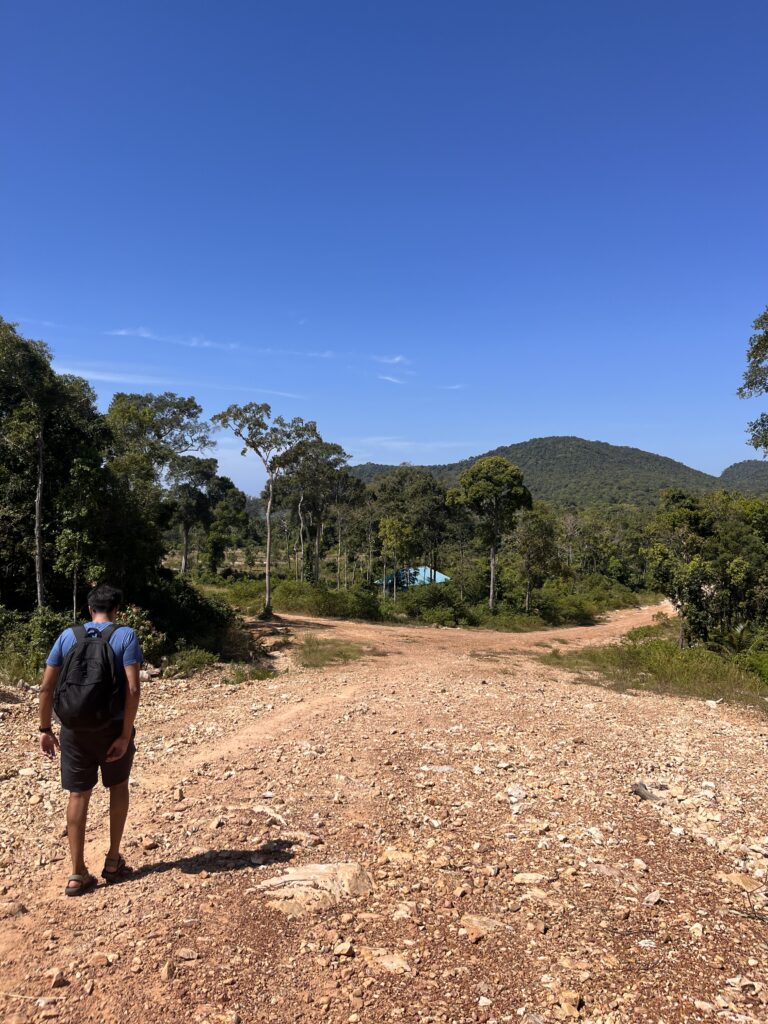
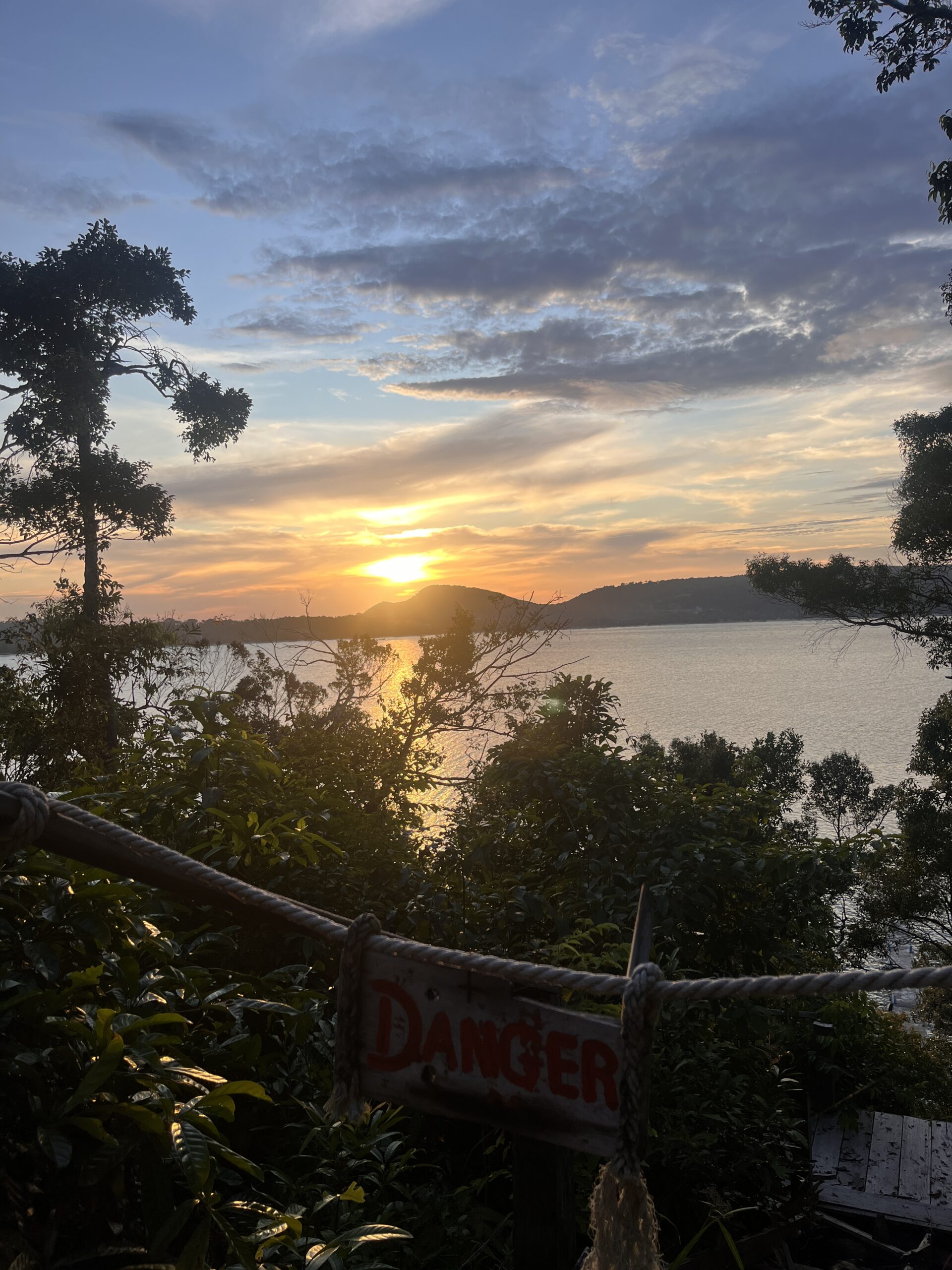
Where to Stay in Koh Rong Samloem
Choosing your base on Koh Rong Samloem will shape your entire experience – how far you walk, how easy it is to do things, how much “off-grid” feel you get. I stayed at Pearl Beach Resort & Spa, and for me it was exactly what I needed. But there are a few other zones worth considering too – I’ll walk you through those below.
Boats usually drop you as close as possible to your accommodation’s pier, but it’s important to confirm this before you book. Some spots require boat transfers or walks through jungle trails.
Pearl Beach Resort & Spa – Secluded Comfort (My Pick)
This is where I stayed – and it quickly became one of my favorite hotel experiences, ever.
- Why I picked it: I wanted to splurge a little for my 30th birthday, but still be somewhere quiet, gentle, and not overrun.
- What it’s like: A hidden gem tucked into the trees with its own private stretch of beach. The only people around are other guests, which keeps the atmosphere calm and intimate.
- You arrive via Paradise Pier, a less-frequented ferry stop.
- Perks I loved: Free kayaks and SUP, a plunge pool on the veranda, massages, and hornbills flitting around the trees.
- Good to know: There’s no nightlife, only one on-site restaurant, and resort transfers run once daily. But if you’re here to unplug – you won’t mind.
Other Areas to Stay (by Vibe & Accessibility)
If Pearl sounds too remote or you’re after something more social, here are the island’s other main beach zones with top places to stay.
| Zone | Vibe & Accessibility | Recommended Stay |
|---|---|---|
| Saracen Bay | Most developed area. Great for walkability, beach bars, and easy access. Most ferries stop here. |
Saracen Bay Resort — Solid beachfront spot with easy access to food, bars, and activities. Sara Resort — Well-reviewed, central location, a good mid-range all-rounder. |
| M’Pai Bay | Rustic, budget-friendly, diving hub. Local village feel. Accessible by a separate ferry pier. |
The Cliff Hostel — Backpacker-friendly with gorgeous views from the cliffs above the bay. On The Rocks — Laid-back, slightly more polished bungalows with sunset views. |
| Sunset Beach | Remote and quiet. Reachable by boat or jungle trek from Saracen. | Robinson Bungalows — Rustic wooden huts right on the beach. Sunset views are unbeatable. |
| Lazy Beach | Harder to reach, extremely chill. Limited crowd, total escape vibe. | Lazy Beach Resort — Beachfront bungalows with hammocks, good food, and zero rush. Worth the journey. |
Things to Do in Koh Rong Samloem
How much you do on Koh Rong Samloem really depends on what you’re looking for. We came to slow down – not check off a list – but even in the slowest of days, the island has its rhythms. Here’s a mix of what we did, what we skipped, and what you might want to plan for.
1. Swim, Walk, and Kayak at the Beach
We stayed at Pearl Beach Resort and Spa, which had its own quiet stretch of shoreline, free paddleboards and kayaks, and just one other resort nearby. I spent most mornings swimming before breakfast, and most afternoons floating in a kayak, watching hornbills hop from tree to tree.
Pearl Beach is a small cove, so you won’t find long beach walks – but nearby Sandy Beach (about 10 minutes on foot) gives you more space to stretch your legs.
If you’re staying elsewhere, Lazy Beach and Sunset Beach are two of the best beaches on the island. Both are slightly trickier to reach (usually via jungle trail or private boat), but worth the effort for their serenity and golden sand. Saracen Bay is more accessible, great for quick dips and casual drinks, while M’Pai Bay has a local vibe and snorkeling potential.
2. Stand-Up Paddleboarding
I used to think SUP was the most pointless water sport, until I found myself gently drifting over glassy water at golden hour. Our hotel had free boards for guests, and I ended up loving it – maybe this is just what turning 30 does to you.
3. Snorkeling
We didn’t book a snorkeling tour because the reef near our resort was easy to access on our own. If you’re staying in M’Pai Bay or Saracen Bay, you’ll find local operators offering snorkeling trips – usually to nearby reefs or out to Koh Koun. Ask your hotel for a trusted guide.
4. Bioluminescent Plankton
One of my favorite moments on the island was swimming with glowing plankton – no tour needed. When we asked around, a guide told us that we didn’t need to pay: just swim left from Pearl Beach at night, and we’d see it. And we did.
Timing matters here: avoid full moon nights, and make sure it’s fully dark. You’ll need to stir the water a bit to activate the glow, and it’s safest to stay away from any rocky or sharp areas. Don’t expect Avatar-style bioluminescence – it’s subtle, but magical.
5. Beach Hikes
If you like your beaches with a side of jungle, you’ll love the short hikes between different bays:
- Saracen Bay → Lazy Beach: A well-trodden 20–30 min hike through the jungle.
- Saracen Bay → Sunset Beach: Slightly longer, a bit steeper – around 40 minutes.
Wear shoes (not flip-flops), bring water, and try to avoid hiking after sunset.
6. Massage
Most mid-range resorts offer on-site massages, and we indulged more than once. It’s not a spa town, but a good beachside massage after kayaking all morning is the kind of luxury that feels well-earned.
7. Diving
We didn’t dive ourselves, but M’Pai Bay is where most of the island’s dive shops are based. If you’re PADI certified (or looking to be), this is the place to go. Koh Rong Samloem is still relatively underdeveloped for diving – which means you’ll get uncrowded spots and decent visibility, especially from November to April.
8. Absolutely Nothing
And finally, the best thing we did: nothing. No itinerary, no obligations. Most afternoons passed with a book in hand or a nap in the shade. If your instinct is to fill your days, Koh Rong Samloem might slow you down in the best way.
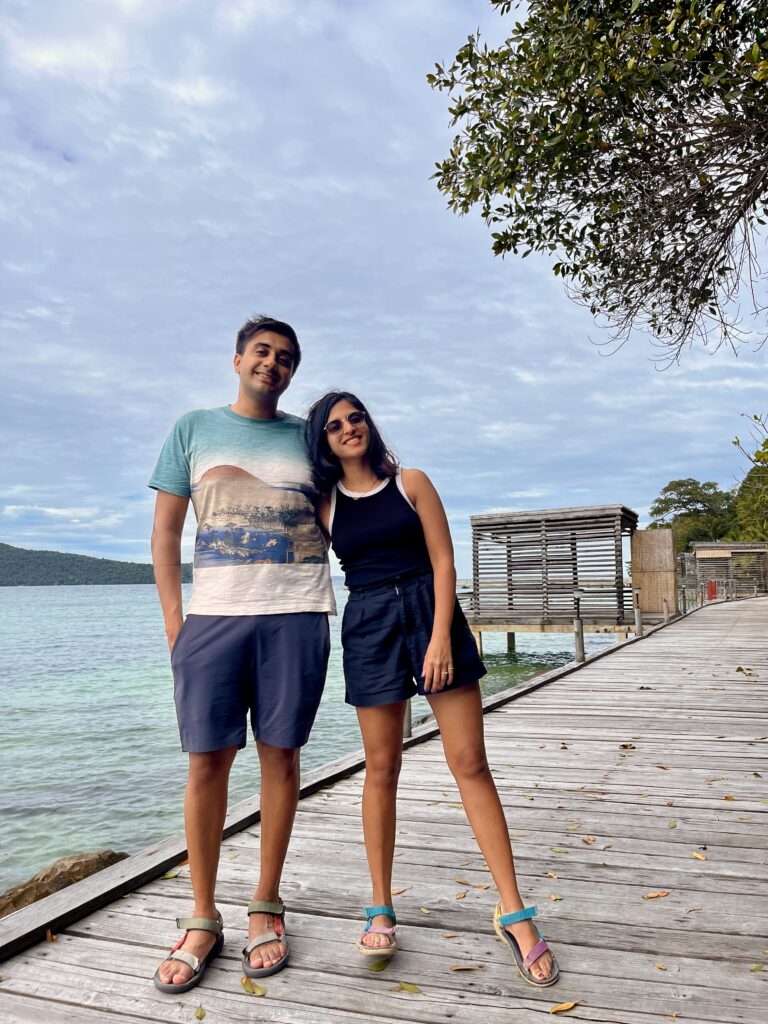
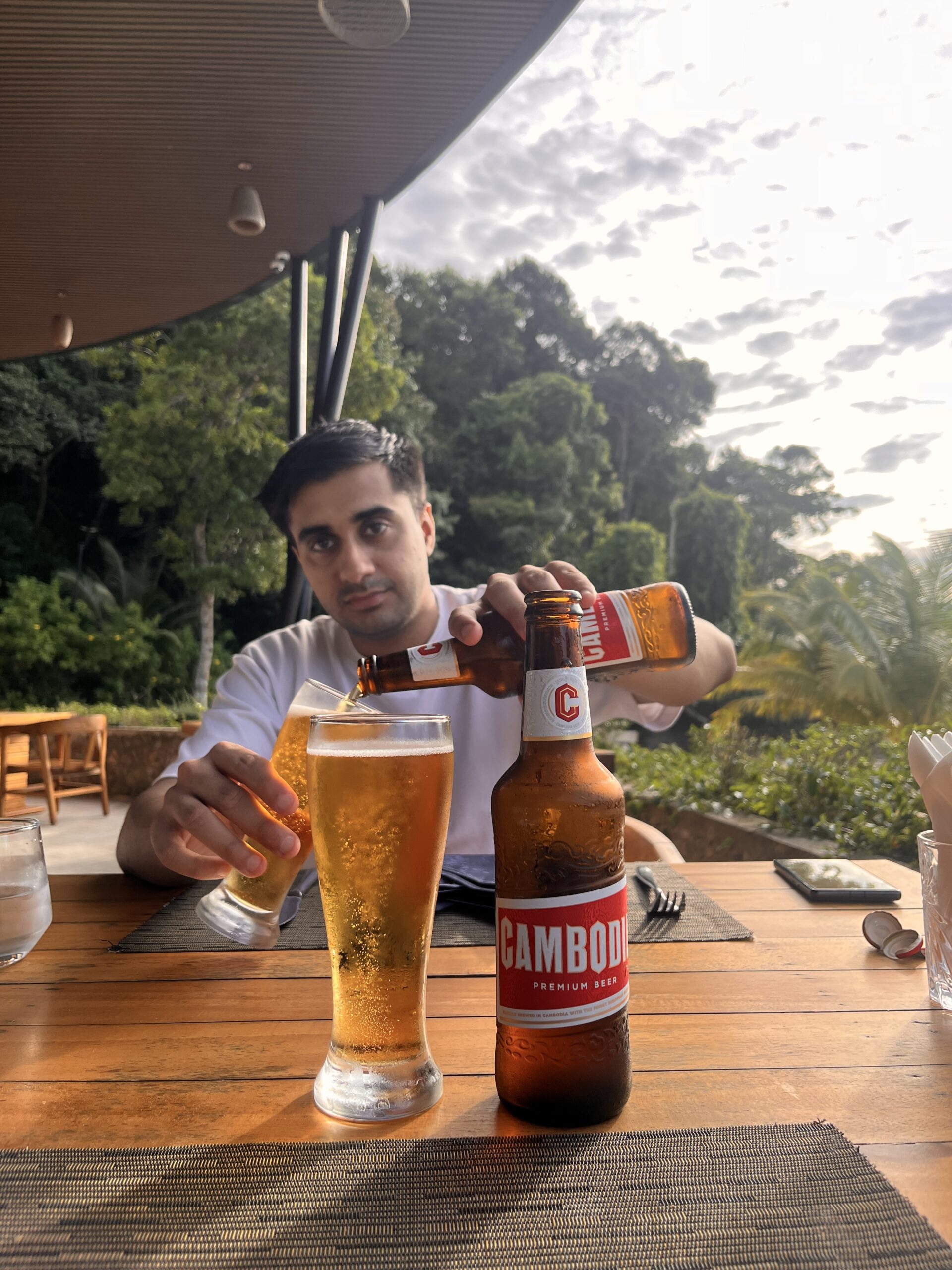
Getting Around on Koh Rong Samloem
Koh Rong Samloem is still roadless – part of its charm. That means there are only two ways to get around: on foot or by boat.
The island’s trails are surprisingly manageable, and if you’re staying on Saracen Bay or Sunset Beach, you can easily walk between the two. The trail takes about 30 to 40 minutes and gives you the chance to see the jungle in between swims. Lazy Beach is also within reach – a short walk from Saracen and not much farther from Sunset.
Boat taxis do exist, but they’re not always available on demand and tend to be expensive. I wouldn’t rely on them as your main form of transport – especially if you’re on a tighter budget or timeline.
M’Pai Bay, on the northern end of the island, is more isolated. Technically, you can hike there from other parts of the island, but it’s a long and challenging trek that most people skip. If you want to see M’Pai (and it’s worth it for the contrast), the best move is to start or end your trip with a couple of nights there, especially if you’re basing yourself at Saracen or Sunset for the rest of your stay.
When to Visit Koh Rong Samloem
The best time to visit Koh Rong Samloem is during the dry season, from November to April. Expect calm seas, sunny days, and manageable humidity – ideal for beach time and ferry reliability.
I visited in early December, and it was a sweet spot: good weather, fewer crowds, and easy logistics.
Avoid the rainy season (May to October) if you can. Heavy rains often disrupt ferry schedules, and swimming or hiking becomes less appealing.
The shoulder months (late October or early May) offer lower prices and fewer tourists, but you might risk the occasional downpour.
How Long to Stay on the Island?
How long you spend on Koh Rong Samloem depends entirely on your pace and priorities. But I would recommend at least a few days to slow down.
I spent five days on the island and didn’t feel like leaving. That was enough time to visit multiple beaches, paddle out each day, and enjoy hours of doing nothing without feeling rushed.
If you’re tight on time, even a couple of nights can give you a feel for the place. But if you’re craving stillness, longer stays reward you with deeper rest.
There’s no right answer here.
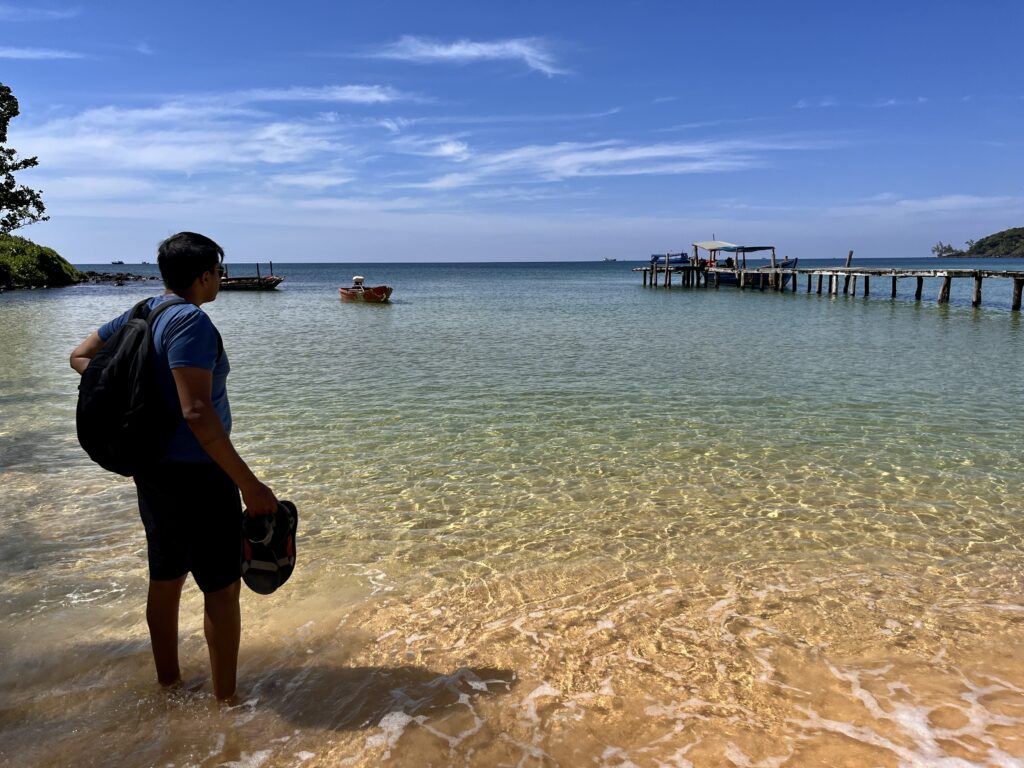
Island Life: What to Know Before You Go
A few practical tips will make your stay smoother:
- WiFi & Cell Reception: Varies by area. Saracen Bay has the best access, but don’t expect fast speeds. Some resorts offer decent WiFi; others barely have signal.
- Electricity: Power cuts are common outside Saracen. Some places run generators at night only.
- ATMs: None on the island. Bring enough cash from Sihanoukville or Phnom Penh.
- Language: Most resort staff speak basic English, but Khmer is the local language.
- Infrastructure: Limited. Expect basic plumbing, solar showers, and occasional plastic waste on trails or beaches – especially after storms.
What’s Next for Koh Rong Samloem? On Development, Disparity, and the Future of Samloem
It’s hard to spend time on Koh Rong Samloem without thinking about how much longer it will stay this way.
Mass tourism has already reshaped much of Cambodia’s coastline, and you can feel its weight in Sihanoukville – a city that’s gone from sleepy port town to a skyline of casinos, luxury towers, and garbage-strewn streets. Much of this change has been fueled by foreign investment, often Chinese-backed, with little regulation or long-term planning.
Koh Rong Samloem still feels removed from all that – but only just. The infrastructure is limited, but the development pressure is real. Land is being bought, plans are being drawn. You get the sense that the clock is ticking.
There’s also the quieter reality that’s harder to ignore the longer you stay: the divide between the experience of tourists and the lives of those who work here. Most of the people cleaning rooms or ferrying supplies in by boat don’t live on the island full-time. Some commute daily, others stay in basic housing tucked behind the resorts. The contrast is sharp.
I tried to be conscious – tipping well, eating at locally run spots, asking questions before taking photos – but that awareness doesn’t dissolve the inequality. If anything, it makes it more visible.
Island life does seem to change people. There’s a softness that creeps in, a slower pace that encourages conversation. But none of that insulates this place from change.
I don’t think Koh Rong Samloem needs to be frozen in time. But I do hope that development here moves slowly, thoughtfully – if it has to happen at all. It would be a shame to lose the quiet, the space, the smallness that make the island what it is.
After the Island
Koh Rong Samloem was the final stop on our Cambodia itinerary – a quiet close to months of constant movement. We spent five days swimming, reading, watching sunsets, and doing very little else. It felt like a reset.
If you’re planning a trip and wondering how this island might fit into the rest of your route, you can see how we structured ours here.
